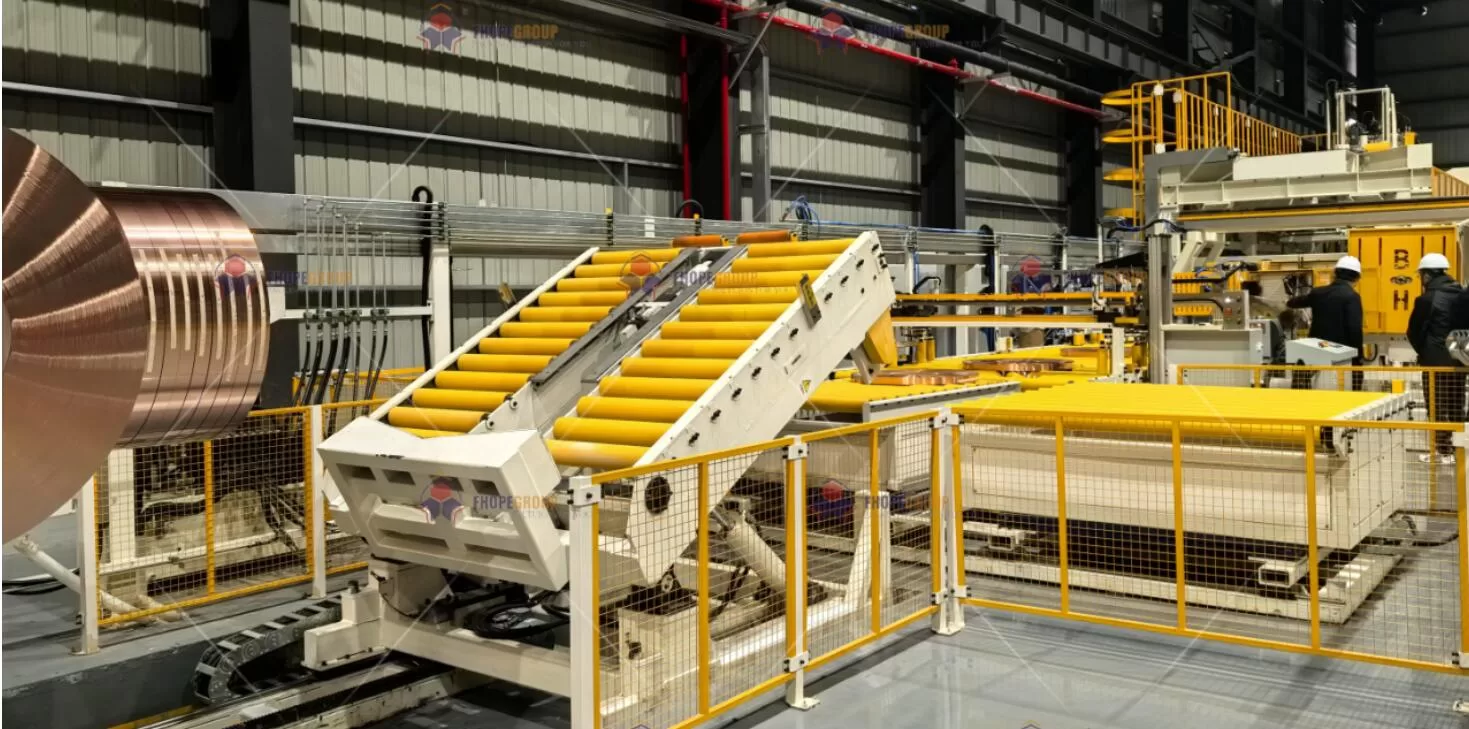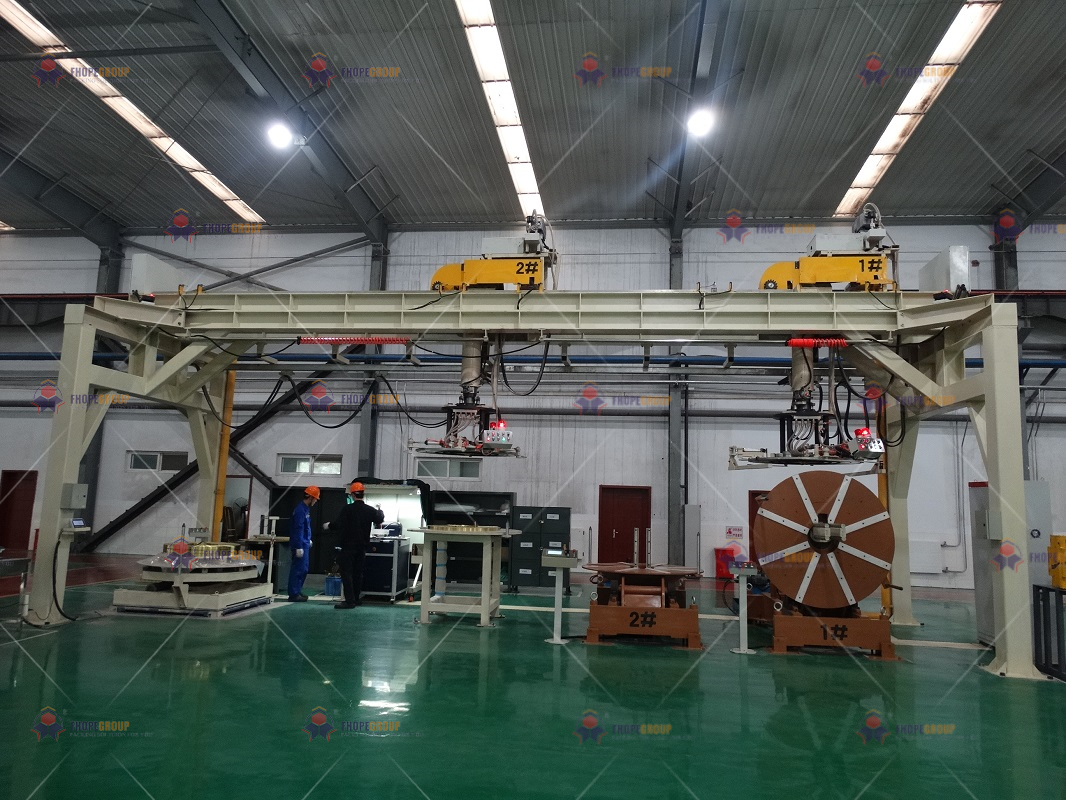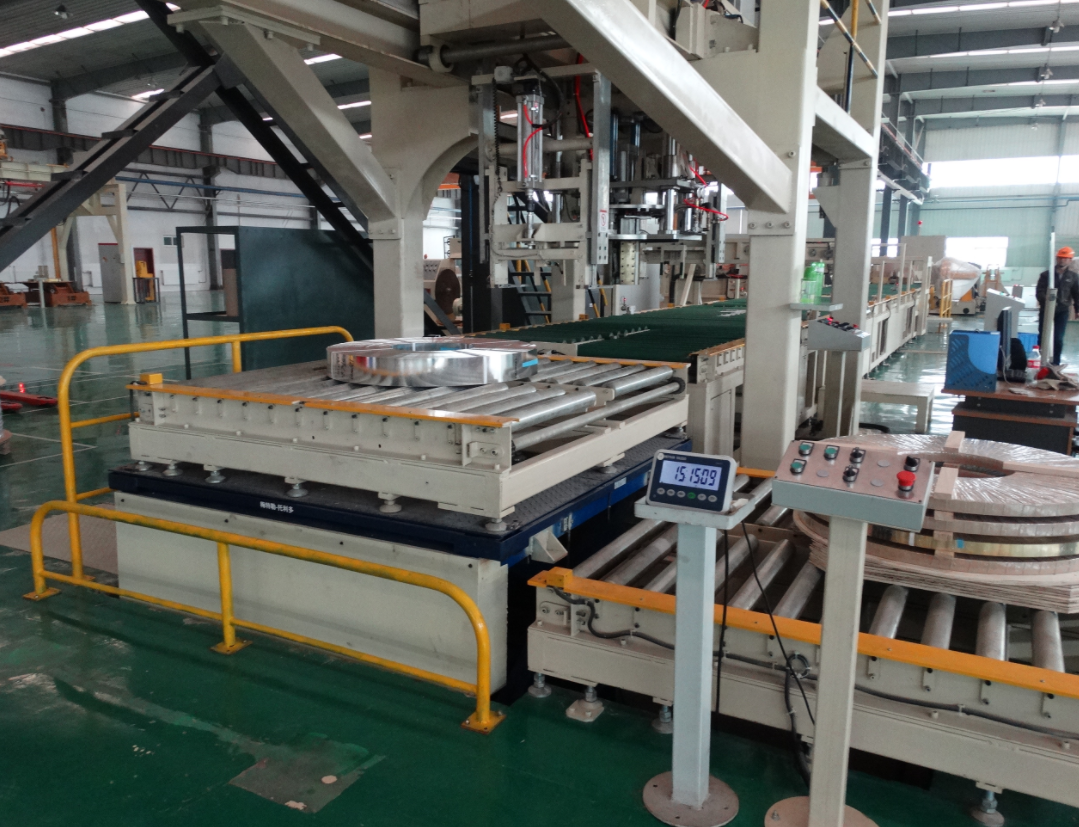Are you running a steel or metal processing facility in Australia? Then you know the pressure is always on. You're constantly balancing the need for high productivity with the absolute necessity of meeting Australia's strict workplace health and safety (WHS) standards. A breakdown or a safety incident in your packing line isn't just an inconvenience; it can halt your entire operation, lead to hefty fines, and put your people at risk. I've seen firsthand how a poorly chosen packing system becomes a bottleneck, a financial drain, and a constant source of worry for plant managers.
The key to a compliant, reliable, and cost-effective coil packing system for the Australian market lies in a partnership approach. It's not about buying a machine off a shelf. It's about working with an expert who understands Australian standards like AS/NZS 4024.1, designs for reliability with high-quality components, and analyzes the Total Cost of Ownership (TCO) to ensure long-term value. A true partner provides a total solution, from initial design and risk assessment to installation, training, and ongoing support, ensuring your investment pays dividends for years to come.

I'm Vincent Liu, founder of SHJLPACK. My journey started on the factory floor as a packing machine engineer. I learned what works and, more importantly, what doesn't. I eventually built my own factory, and over the years, I've helped countless clients, just like you, navigate these very challenges. I believe that knowledge should be shared. In this article, I want to walk you through the critical factors you need to consider when selecting a coil packing system. We'll move beyond the sales pitch and get into the real engineering and business sense behind making a smart, strategic investment for your facility.
How do you ensure your packing line meets strict Australian safety standards?
You're looking at a new packing line, and the specifications seem great. But a nagging thought persists: will it actually pass a safety audit in Australia? The fear of installing a multi-thousand-dollar system only to have it flagged for non-compliance is very real. It can lead to expensive retrofitting, production delays, and serious legal exposure. I've heard stories from plant managers who were sold a "compliant" machine, only to find it fell short of AS/NZS standards, turning their investment into a major liability.
You ensure full compliance by making it a non-negotiable part of the procurement process from day one. This involves demanding that any potential supplier provides a detailed risk assessment based on AS/NZS 4024.1 (Safety of machinery) and can prove the electrical systems meet AS/NZS 3000 (Wiring Rules). It means looking beyond the base machine and scrutinizing the safety components—the light curtains, the emergency stops, the physical guarding, and the control system's safety circuits. True compliance isn't a sticker on a machine; it's a philosophy built into its very design.

Diving Deeper into Australian Compliance
When we talk about safety standards in Australia, we're not just talking about suggestions; these are legal requirements. For anyone in the steel and metal coil industry, understanding the fundamentals of these standards is crucial. It’s not just about protecting your workers, which is the number one priority, but also about protecting your business from the significant risks of non-compliance.
The cornerstone is AS/NZS 4024.1: Safety of machinery. This standard isn't a simple checklist. It's a framework for a comprehensive risk management process. A compliant supplier won't just sell you a machine; they will work with you to conduct a risk assessment specific to how the machine will be used in your facility. This involves identifying all potential hazards during operation, maintenance, and cleaning, and then implementing control measures to eliminate or minimize those risks. This is where features like safety interlocks on access gates, light curtains that stop the machine if a person enters a dangerous area, and two-hand controls for certain operations become critical.
Another major area is electrical safety, governed by AS/NZS 3000: Electrical installations (known as the Australian/New Zealand Wiring Rules). This standard dictates how all electrical components must be installed, protected, and earthed. It covers everything from the size of the wiring to the type of circuit breakers and the placement of control panels. I once visited a plant where a new machine from a different supplier was causing constant electrical trips. The issue was traced back to improperly specified components that weren't suited for the power demands and industrial environment, a clear violation of the Wiring Rules. This is why we, at SHJLPACK, insist on using globally recognized and certified components like Siemens or Allen-Bradley, which are well-documented and meet these stringent requirements.
Here is a simple breakdown of what to look for:
| Safety Feature | Non-Compliant System (The Red Flags) | Compliant System (The Green Lights) |
|---|---|---|
| Guarding | Basic mesh panels with simple bolts. Easy to remove or bypass. | Fixed physical barriers or interlocked gates that stop the machine when opened. |
| Emergency Stops | One or two poorly placed E-stops. Not easily accessible from all points. | Prominent, easily accessible E-stop buttons at every operator station and key hazard point. |
| Control System | Basic PLC with no safety-rated components. | Safety PLC or safety relays that are fail-safe, meaning a component failure leads to a safe state. |
| Documentation | Vague manual, no risk assessment, no electrical schematics. | Comprehensive documentation, including a detailed risk assessment, full electrical diagrams, and operating procedures. |
Ultimately, a compliant machine is the result of a deliberate design process. It requires a supplier who has experience with Australian standards and is willing to invest the time and engineering resources to get it right. It's a conversation you need to have at the very start of your project.
What makes a coil packing system truly reliable for continuous operation?
Your production line is humming, hitting targets for the shift. Suddenly, an alarm sounds from the packing area. A sensor has failed on the wrapping machine, and the entire line grinds to a halt. Now your operators are idle, the upstream slitter is backing up, and you're missing shipping deadlines. This scenario is a plant manager's nightmare. Relying on equipment that is prone to frequent, unplanned downtime is like trying to build a business on a foundation of sand. It erodes efficiency, profitability, and morale.
A truly reliable coil packing system is born from robust engineering, not wishful thinking. It's a combination of three key elements: first, the use of high-quality, durable components from reputable brands for motors, PLCs, and sensors. Second, a simple and strong mechanical design that avoids over-complication and has fewer points of failure. Third, it is designed for ease of maintenance, with accessible parts and ideally, the capability for predictive maintenance through modern sensors and diagnostics. Reliability isn't an accident; it's a deliberate choice made during the design and manufacturing stages.

Diving Deeper into System Reliability
For a business owner like Javier Morales, who aims for 95% equipment uptime, reliability is not a feature—it is the core function. In my years of designing and building these machines, I've learned that reliability boils down to a few fundamental principles that you can actively look for.
First is Component Quality and Standardization. The overall reliability of a machine is only as strong as its weakest component. It’s tempting for manufacturers to cut costs by using generic or lesser-known brands for things like PLCs, variable frequency drives (VFDs), sensors, and bearings. This is a false economy. A failed sensor that costs $50 can halt a production line that generates thousands of dollars per hour. That's why we standardize on globally recognized brands like Siemens, SEW-Eurodrive, and Omron. These components are not only rigorously tested and built for harsh industrial environments, but they are also readily available in most parts of the world, including Australia. This means if a part does fail, you can source a replacement quickly instead of waiting weeks for a proprietary part to be shipped from overseas.
Second is the principle of Simplicity in Design. I've seen some incredibly complex machines that look impressive on paper but are a nightmare to maintain. More moving parts, more complex software logic, and more custom-made components often mean more things can go wrong. A great design is often the simplest one that gets the job done effectively. For example, a robust, gear-driven turntable is almost always more reliable in the long run than a complex belt or chain system that can stretch, slip, or break. The design should prioritize strength and durability, using heavy-gauge steel for the frame and oversized components where stress is high.
Finally, we need to talk about Maintenance Strategy. The old model of "run-to-failure" is no longer acceptable. A modern packing line must be designed for proactive maintenance.
| Maintenance Type | Description | Impact on Reliability |
|---|---|---|
| Reactive | Fix it when it breaks. | Very low reliability. Leads to maximum unplanned downtime and high repair costs. |
| Preventive | Scheduled maintenance based on time or cycles (e.g., lubricate bearings every 500 hours). | Good reliability. Reduces surprise failures but can lead to unnecessary maintenance. |
| Predictive | Using sensors (for vibration, temperature, etc.) and data to predict when a component will fail. | Excellent reliability. Maximizes uptime by allowing maintenance to be scheduled just before a failure occurs. |
A reliable system facilitates a move towards predictive maintenance. It might include features like IoT-enabled sensors that monitor motor temperature or vibration, sending alerts when readings go outside normal parameters. It should also have easily accessible lubrication points, modular sub-assemblies that can be swapped out quickly, and a clear maintenance manual. This is the path to achieving that 95% uptime goal.
How can you achieve a cost-effective packing solution without sacrificing quality?
The pressure to control costs is universal. You receive a quote for a new packing line, and the initial capital expenditure looks high. The temptation is to find a cheaper alternative, a machine that does "mostly" the same thing for a fraction of the price. But I've seen this play out many times. The "cheaper" machine consumes more wrapping material, needs more frequent maintenance, and requires more labor to operate. Within a few years, the hidden operational costs have completely erased the initial savings, and you're left with an inefficient machine that's hurting your bottom line.
The path to a truly cost-effective solution is to shift your focus from the initial purchase price to the Total Cost of Ownership (TCO). A smart investment might have a higher upfront cost but will save you money every single day of its operation. This is achieved through intelligent design that minimizes waste, optimizes energy consumption, and reduces labor dependency. It’s about choosing a machine that is an asset that generates value, not a liability that drains resources.

Diving Deeper into Total Cost of Ownership (TCO)
For a forward-thinking owner like Javier, every investment is scrutinized for its return. This is exactly the right mindset. A packing line is not a one-time purchase; it's a long-term operational asset. To understand its true cost, we must analyze its TCO over its expected lifespan, typically 10-15 years.
TCO can be broken down into two main categories: CAPEX (Capital Expenditure) and OPEX (Operational Expenditure).
- CAPEX is the initial price you pay for the machine. This is the most visible cost, but often the least significant over the machine's life.
- OPEX is the ongoing cost to run and maintain the machine. This is where the real savings (or losses) are found.
Let's break down the key drivers of OPEX and how a well-designed machine can drastically reduce them:
-
Consumables (Wrapping Material): This is a huge and often underestimated cost. A basic wrapping machine might not have a powered pre-stretch system, meaning the film is just pulled around the coil. A high-quality machine will have a powered pre-stretch unit that can stretch the film by 200-300%. This means for every one meter of film on the roll, you get three to four meters of wrapping on your coil. This can cut your film consumption by 50-75%, a massive saving that accumulates every single day.
-
Energy Consumption: A packing line runs for hours on end. Inefficient motors and a lack of smart controls can lead to high electricity bills, a major challenge given volatile energy prices. A cost-effective machine uses high-efficiency motors (IE3 or IE4 rated) and Variable Frequency Drives (VFDs). VFDs allow the motors to ramp up and down smoothly and run at the precise speed needed, rather than running at full power all the time. This can reduce energy consumption by 15-30%.
-
Labor Costs: How much manual intervention does the machine require? A basic system might need an operator to manually attach the film, cut it, and then move the coil. A more automated system can handle this entire sequence automatically. While automation adds to the initial CAPEX, the reduction in labor costs over several years provides a clear and calculable return on investment.
Let's look at a simplified TCO comparison over 10 years:
| Cost Factor | "Cheap" Machine (Low CAPEX) | "Cost-Effective" Machine (High-Value) |
|---|---|---|
| CAPEX | $80,000 | $120,000 |
| Annual Film Cost | $40,000 (No pre-stretch) | $15,000 (250% pre-stretch) |
| Annual Energy Cost | $8,000 | $6,000 (VFDs, IE3 motors) |
| Annual Maintenance | $5,000 (Frequent downtime) | $2,000 (Reliable components) |
| Total 10-Year OPEX | $530,000 | $230,000 |
| 10-Year TCO | $610,000 | $350,000 |
As you can see, the machine that seemed "expensive" upfront is actually the far more cost-effective choice, saving the business $260,000 over a decade. This is the kind of analysis that turns an equipment purchase into a strategic business decision.
Why is a "total solution" provider a better partner than a simple equipment supplier?
You've found a machine online from a supplier. The price is right, and you place the order. The machine arrives in a crate, but the journey has just begun. Now you have to figure out how to integrate it with your existing conveyor system, get your local electrician to wire it correctly, and train your staff based on a poorly translated manual. When a problem arises, the machine supplier blames the installer, and the installer blames the machine. You're stuck in the middle, wasting time and money.
This siloed approach is a common pitfall. A simple equipment supplier sells you a product. A "total solution" provider, on the other hand, delivers an outcome. They become a strategic partner who takes responsibility for the entire project lifecycle, from understanding your unique needs to ensuring the system is running smoothly on your factory floor and supporting you long after the sale. This integrated approach de-risks your investment and ensures you get the performance and reliability you paid for.

Diving Deeper into the "Total Solution" Philosophy
My slogan for SHJLPACK is "TOTAL SOLUTION FOR WRAPPING MACHINE" for a very personal reason. When I was an engineer, and later when I started my own factory, I saw the immense gap between what equipment sellers promised and what they delivered. The real work isn't just building a machine; it's making that machine a seamless, productive part of a client's operation. That's the philosophy I built my company on. For a decision-maker like Javier, who seeks strategic partners, this difference is everything.
So, what does a "total solution" actually look like in practice? It's a multi-stage process where we act as your expert guide.
-
Consultation and Design: This is the most critical phase. We don't start by showing you a catalog. We start by asking questions. What are the dimensions and weights of your coils? What is your required throughput? What does your factory layout look like? We analyze your entire workflow, from the moment a coil comes off the slitter to the moment it's ready for warehousing or shipping. We then design a system—which might include conveyors, tilters, strapping machines, and wrapping machines—that is custom-fit to your exact needs. This includes planning for future growth and ensuring compliance with local standards like those in Australia.
-
Seamless Integration: A packing line doesn't operate in a vacuum. It needs to "talk" to the systems before and after it. A total solution provider handles this integration. We ensure the control system of our packing line can communicate with your main production control system (MES). This allows for automated data exchange, so a coil's ID can be tracked from creation through to final packaging, enabling the kind of comprehensive production visualization that is a key goal for modern factories.
-
On-Site Installation and Commissioning: Our responsibility doesn't end when the truck leaves our factory. A true partner provides engineers on-site to supervise the installation, connect the machinery, and perform rigorous testing. This commissioning phase is where we fine-tune the system in its real-world environment, ensuring all components work together flawlessly and that the machine performs to the agreed-upon specifications.
-
Comprehensive Training and Support: A machine is only as good as the team operating it. We provide in-depth training for both operators and maintenance staff. We teach them not just how to run the machine, but how to perform routine maintenance, troubleshoot common issues, and understand the safety systems. After we leave, our support continues. With modern remote access capabilities, our engineers can often diagnose and even resolve software issues from our own office, minimizing your downtime.
Choosing a partner who provides this end-to-end service transforms a simple purchase into a strategic collaboration. It builds a foundation of trust and ensures that your investment will deliver value for its entire operational life.
Conclusion
Choosing the right coil packing system is a major strategic decision. To do it right, look beyond the price tag. Focus on proven compliance with Australian standards, engineered reliability, and the long-term value offered by a low total cost of ownership.





